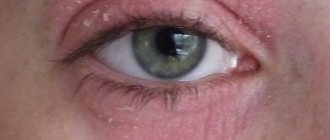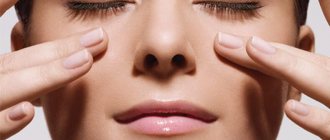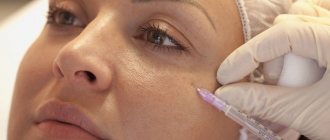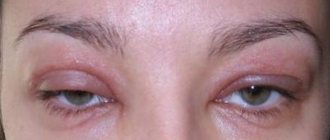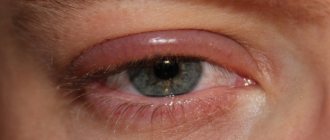If parents notice redness around their child's eyes, they need to find out why this happened and how to fix the problem. To do this, you should consult a doctor and together with him determine treatment tactics. Additional symptoms can tell you a lot: swelling, increased body temperature, itching, pain, sleep disturbance.
Common reasons
Around the human organs of vision there are very delicate tissues that are susceptible to infections and allergens: eyelids, tear ducts, highly sensitive skin. Therefore, the causes of redness around the eyes in adults and children can be very different. Conventionally, they are divided into internal and external.
External ones include:
- using cosmetics to which adults may be allergic. Either the product itself is of poor quality or expired;
- stress or psycho-emotional overstrain, during which hormones are intensely produced, causing redness of the skin around the eyes;
- allergic reaction to any irritant;
- intolerance to the medications used;
- injuries, mechanical damage to the skin.
Eliminating provoking factors will help completely get rid of the unpleasant symptom. However, in some cases, recovery will require the use of drug therapy.
Internal causes include various diseases in which swelling and redness of the face around the eyes are observed:
- liver diseases;
- fungal infections;
- infectious diseases;
- viral infections (herpes, adenovirus);
- metabolic disease;
- dermatological diseases;
- inflammatory processes;
- hypertension and hypertension.
Such problems require diagnosis and adequate treatment, which must take place under medical supervision.
Allergy
Due to the body's immune response to foods, chemicals, detergents, cosmetics, dust, wool, pollen, children and adults may experience redness and itching around the eyes.
Important! An allergy is an unexpected reaction of the body to some irritant. It can occur in both children and adults.
Adenoids
If adenoid formations begin to grow, they block the nasopharynx. As a result, the child develops snoring and wheezing, and there is also redness of the skin around the eyes.
Vegetovascular dystonia
Redness and swelling near the eyelids are sometimes diagnosed as a result of pathology caused by a malfunction of the regulatory activity of the autonomic nervous system.
Fatigue
Due to chronic overstrain of the visual apparatus, redness of the skin around the eyes may occur. If you do not give the body a rest, the problem will worsen, negatively affecting the nervous system.
Mechanical damage
Friction of the skin, scratching, impact - all this can cause redness around the eyes and eyebrows.
Insect bites
After an insect bite you may experience:
- severe tissue swelling;
- itching, burning;
- redness;
- increase in body temperature;
- pain syndrome;
- general malaise.
Redness in the area of the bite and eyelids occurs as an allergic reaction in both adults and children.
Hemangioma
This is a benign neoplasm in infants that forms under the eye and consists of vascular tissue. It looks like a red-blue spot with uneven outlines. The tumor may not appear immediately, but only a few weeks after birth.
Papilloma
A benign growth with a soft or dense structure. It protrudes slightly above the surface of the skin and does not cause discomfort. It can occur in both adults and children.
Kidney diseases
The presence of stones, renal failure and other pathological processes occurring in the kidneys are reflected on the skin with swelling, bags, circles, redness, darkening around the eyes.
Heart diseases
In case of heart pathologies, the fundus arteries undergo changes, as a result of which the patient may complain of redness of the eyelids, headaches, pain in the area of the eyeballs, and blurred vision.
Eye injuries
The main symptoms of mechanical damage to the visual organ include hemorrhage in various parts of the eye, the formation of edema, hematomas, and redness in the eyelid area.
Angina
An infectious disease that occurs due to the penetration of pathogenic bacteria and viruses into the body. Redness around the eyes in a child can occur during an exacerbation of the disease.
Viral conjunctivitis
Most often, the disease is transmitted through household contact from infected people or animals. The risk group includes young children, people with weakened immune systems, and people forced to take antibiotics for a long time. First, a person complains of a burning sensation in the area of the affected eye, then redness, swelling of the eyelid, and purulent discharge are observed.
Dental diseases
Redness in the nose and eyelids in some cases is a symptom of oral diseases. For example, children often suffer from caries, which must be treated promptly and not neglected.
Important! Even if a child has baby teeth, he should have an annual dental checkup.
Skin inflammation
Both children and adults face this problem. The inflammatory process can develop against the background of infectious or allergic phenomena, causing dysfunction of the visual apparatus, and accompanied by pain, induration, severe lacrimation, swelling, and photophobia.
There are several types of inflammatory diseases, which have their own causes and pronounced symptoms:
- blepharitis;
- chalazion;
- barley.
Blepharitis
It can serve as a symptom of any pathology or manifest itself as an independent disease. This is an inflammation that affects the edges of the eyelids and corners of the eyes. Accompanied by swelling, swelling of the eyelids, burning, and the appearance of a thin crust below the organ of vision.
Inflammation in the corner of the eye
The human body is often exposed to various inflammatory processes that develop for various reasons. It can be infectious or non-infectious. By their nature, all these processes have similar symptoms, but depending on the location or severity they may differ.
Whatever the reasons for the development of the inflammatory process, its nature inevitably leads to disruption of the basic functions of this organ. Inflammation in the corner of the eyes, despite the insignificant area of the lesion, affects a person’s quality of life, disrupting the organ’s perception of the environment, as well as blocking its basic functions.
The inflammatory process causes discomfort, bringing discomfort and pain. Symptoms can appear both on the outside and inside the corner of the eyes. The pain syndrome can occur suddenly or be temporary, or it can be permanent.
In addition, inflammation in the corners of the eyes is accompanied by unpleasant symptoms:
- itching;
- burning;
- redness of soft tissues in the affected area;
- swelling;
- redness of the sclera;
- discharge from the eye;
- increased lacrimation.
The appearance of at least one of these signs is a reason to immediately consult a doctor. The process cannot be delayed, since any violations can result in irreversible vision impairment or even loss.
Other reasons
Itching, redness and peeling of the skin around the eyes can be caused by somatic diseases, both congenital and acquired. The main reason for their occurrence is nervous shock, against which serious illnesses develop, for example, glaucoma, cataracts, diabetes, hormonal imbalance, and pathologies affecting internal organs.
Genetic individual trait
Congenital skin pathologies (for example, pigment spots) can be localized in close proximity to the organs of vision, causing the visual sensation that the eyelids are red and constantly swollen.
Worm infections
Redness and peeling of the skin around the eyes provoke helminthic infestations. They suppress the body's immune system, which leads to inflammation of the skin of the eyelids and the development of blepharitis.
Age characteristics of children 1-3 years old
Redness and swelling around the eyes in newborns and children under 3 years of age indicates that an inflammatory process of an infectious nature is developing in the body. It may be accompanied by intoxication of internal organs and systems.
In addition, redness can be caused by:
- changes in the circulatory and lymphatic system;
- tendency to colds;
- illnesses and teething;
- genetic predisposition;
- ailments affecting the liver, kidneys, heart;
- anemia.
Since the cause of alarming symptoms can be hidden in any factor, only a doctor can tell you what to do to eliminate it.
Localization of redness
When making a diagnosis, the specialist must pay attention to where exactly the eyelids are red: above, below, under both eyes or just under one.
Under both eyes
The cause of redness around the eyes and the presence of swelling in this case may be an adenoviral infection, allergies, bacterial infection, or dry eye syndrome.
Under one eye
If a child or adult has redness under one eye, this may be a sign of conjunctivitis, barley, furunculosis, herpes, erysipelas, endophthalmitis.
Redness of the eyelids
Constant redness of the eyes and eyelids is associated with vegetative-vascular dystonia, hypothyroidism, cancer, dermatitis, abdominal dropsy, pathologies of the heart and blood vessels.
Why does it sting my eyes?
Anyone can experience pinching in the eye area, regardless of occupation or age category.
Additional symptoms of tingling include excessive tearing, pain, burning or itching.
It is possible to eliminate the unpleasant sensation only after identifying the factors that provoke the symptom. The reasons for the development of a pathological condition in the area of the visual apparatus are varied; these can be eye diseases, as well as cosmetics or procedures.
Symptoms
Pinching of the organs of vision is accompanied by additional symptoms, on the basis of which the provoking factor is determined:
The intensity of the symptom may increase in the evening and subside in the morning. Depending on additional signs and severity of symptoms, we can talk about provoking factors.
Causes
By eliminating the root cause, the manifestation can be completely eliminated. The main factors provoking the symptom are:
Eye strain
Working for a long time in front of a gadget or computer monitor leads to visual fatigue.
Overexertion is characterized by symptoms:
- tearfulness;
- pinching;
- redness;
- decreased moisture content of the mucous membrane.
When working hard, a person forgets to blink, which causes the development of overstrain of the visual apparatus. To relieve tension in the visual organ, it is necessary to take short but frequent breaks.
Performing eyelash extensions
As a result of the cosmetic procedure, minor damage to the organs of vision is possible due to mechanical injuries from forceps or microscopic scratches. An allergic reaction to the chemical components of the substances that are necessary for extensions is also possible:
- degreasing preparations;
- humidifiers;
- glue evaporation;
- lint from cotton swabs;
- artificial eyelashes;
- insufficient cleaning of materials after the previous extension.
To prevent pinching, it is necessary to conduct allergy tests for materials used for cosmetic manipulation, and also maintain sterile conditions.
Cosmetics
Due to the high content of alkaline components, which irritate the mucous membrane of the eyes, stinging may occur.
These hygiene care products include:
- makeup remover tonics;
- shower gels;
- bubble baths;
- shampoos;
- soap.
If a pathological condition occurs due to the use of drugs, it is necessary to rinse the visual organs with copious amounts of water. After eliminating the effects of a cosmetic product, it is necessary to limit its use in the future.
Visual allergies
Allergens that irritate the mucous membrane of the visual organs can also provoke the development of symptoms. Additional signs of the development of an allergic reaction are:
- hyperemia of the eyeball or conjunctiva;
- profuse lacrimation;
- swelling of the eyelids;
- intensive scratching.
The development of the pathological condition can be prevented by taking medications or eliminating the allergen.
Tingling due to wearing lenses
Discomfort is felt due to prolonged wearing of contact correction products or improper use of the product. Additional provoking factors are:
- failure to maintain hygienic care of the device;
- the presence of foreign particles in the eye;
- accumulation of protein compounds or contaminants in lenses;
- using the solution to clean the device several times;
- long-term use of contact correction products;
- improper storage of lenses;
- presence of small scratches on the product;
- unsuitability of lenses;
- increased sensitivity of the eyes to contact agents.
If you experience discomfort during the day, it is advisable to take a break from using contact correction devices.
Dry eye syndrome
The syndrome occurs due to prolonged work at the monitor, insufficient production of tear secretion or dacryocystitis. Initially, the pathology is accompanied by a burning and tingling sensation. To eliminate the syndrome, it is necessary to instill artificial tears or blink rapidly.
To prevent drying out of the mucous membrane of the eyes, take breaks during increased load on the visual apparatus.
Tingling due to putting drops into the eyes
The appearance of tingling of the organs of vision is also characterized by the use of medications. The main side effects due to instillation are:
- burning;
- intensive scratching;
- swelling;
- hyperemia.
Adverse symptoms are often caused by non-compliance with dosages or medication regimen. Allergic manifestations to the component composition of the medication are possible.
Dacryocystitis
The disease is characterized by an inflammatory reaction in the lacrimal canal area. Due to the appearance of difficult access of lacrimal secretion to the mucous membrane, a slight stinging of the eyes appears. Dacryocystitis is located both in the area of the visual organs, and under or above them.
Additional factors that provoke pinching are excessive accumulation of foreign particles on the mucous membrane:
- microvilli;
- infectious agents;
- dust.
Women, people over 30 years of age and newborns are most often affected by the disease.
Herpes of the visual organs
The presence of a herpetic lesion is indicated by symptoms:
- tingling;
- hyperemia;
- formation of rashes;
- feeling of pain;
- intensive scratching.
The infection affects any area of the eye, from the eyelids to the cornea. The presence of severe symptoms indicates the need for therapy.
It stings a child's eyes
If a child has a symptom, it is necessary to apply a compress with chamomile in the pinching area. Sometimes rinsing the eyes under running water at room temperature can also eliminate pinching. For any tingling in patients of a younger age category, consultation with an ophthalmologist or pediatrician is necessary.
Why do my eyes sting from crying?
With increased stress or emotional overstrain, adrenaline is released along with tear fluid. An excess of this substance causes tingling of the organs of vision. If a symptom is observed after the release of tears, it is necessary to consult an ophthalmologist to determine other provoking factors:
- the presence of microscopic cracks or damage on the cornea;
- eyelid injuries;
- formation of pathological areas in the area of the visual apparatus;
- infection with pathogenic microflora.
Diagnosis of the disease
Puffiness, swelling around the eyes, redness and peeling are a clear sign that you need to visit an ophthalmologist, especially when similar symptoms are observed in a small child.
The doctor will conduct a visual examination and, if necessary, prescribe laboratory or hardware diagnostics:
- general blood and urine testing;
- biopsy;
- histology;
- allergy tests;
- Ultrasound.
Based on the results of the examination, a diagnosis will be made and treatment will be prescribed.
Detailed examination and diagnosis
In the vast majority of cases, the doctor makes a diagnosis after an external examination of the patient and collection of anamnesis based on the clinical picture. The doctor determines whether the patient has an elevated body temperature, the presence of erythema, the nature of the swelling (bilateral or unilateral) and the degree of pain.
When is additional research needed for eyelid edema?
Diagnostic examinations are necessary for trauma, subcutaneous cellulitis, cavernous sinus thrombosis and systemic diseases.
Every situation is considered.
- For example, in the presence of bilateral painless swelling, which does not have redness, it suggests an allergic reaction, a systemic disease of the body. Often this type of swelling is caused by a herniated orbital fat.
- Bilateral or unilateral (less often) painless swelling that has redness, most often the result of blepharitis, conjunctivitis or a burn.
- With unilateral painless swelling with redness, one can assume an insect bite, cellulitis, or diseases of the lacrimal system (canaliculitis or dacryoadenitis).
- Unilateral swelling with pain of varying intensity is most often a consequence of orbital cellulitis.
Treatment of pathology
Therapeutic measures depend on the identified pathological process. The specialist, based on the individual characteristics of the patient (weight, age) and the severity of the disease, can prescribe the following medications:
Antiallergic drugs
The following drugs are used:
- Visine (cost 370 rubles);
- Allergodil (costs 450 rubles)
- Ketotifen (cost from 80 rubles).
Visin Allergodil Ketotifen
In advanced cases, drugs containing hormones are prescribed:
- Dexapos (cost 70 rubles);
- Dexamethasone (costs 120 rubles);
- Maxitrol (price 560 rubles).
Dexapos Dexamethasone Maxitrol
Antiviral drugs
They strengthen the immune system, eliminate infection, reduce the risk of complications and exacerbations, relieve pain, and speed up the healing process:
- Oftalmoferon (cost 270 rubles);
- Oftan Idu (cost from 90 rubles);
- Poludan (costs from 95 rubles);
- Aktipol (costs from 270 rubles);
- Adgelon (cost from 650 rubles);
- Tobradex (price 446 rubles);
- Futsitalmic (costs 266 rubles);
- Okomistin (cost 170 rubles).
Antimicrobials
For infectious diseases, the use of antibacterial eye drops is indicated, among which the following are considered the most popular and effective:
- Tobrex (cost from 170 rubles);
- Tsifran (costs 187 rubles);
- Gentamicin (costs 95 rubles);
- Levomycetin . Can relieve red eyes in infants and adults. Inexpensive, accessible drug. Costs 60 rubles.
Torbex Cifran Gentamicin Levomycetin
Remedies against demodicosis
Dermatologists prescribe antibiotics for dermodicosis:
- Trichopolum (cost 83 rubles);
- Ornidazole (cost 94 rubles);
- Metronidazole (costs 160 rubles).
Ornidazole Trichopolum Metronidazole
Additionally, immunomodulators and sedatives are used.
Treatment for eye irritation
Treatment for redness caused by eye irritation is based on:
- using cold compresses and tea bags. They remove swelling, redness, and discomfort;
- washing eyes with rose water. 5 drops of the product are dissolved in a glass of warm water and the procedure is carried out in the morning and evening hours. Rinsing is done by instilling the prepared solution with a pipette, 3-5 drops each;
- using herbal infusions as compresses. They help remove dryness and redness if you steam a large spoonful of herbal raw materials in a glass of boiling water, leave for half an hour, strain, soak pieces of cloth in the prepared solution and apply to the eyelids for 5-7 minutes.
Traditional methods of treatment
When deciding how to remove painful redness and burning in the eyelid area using folk methods, it is necessary to exclude ophthalmological diseases, photos of which can be viewed on the Internet.
They help a lot:
- Parsley or dill lotions. Fresh herbs are finely chopped and wrapped in clean gauze pieces, and then applied to the eyes for 10 minutes.
- Chamomile decoction. Gauze is soaked in it and also applied to the eyelids.
- Baking soda can remove redness if you soak gauze in a weak soda solution and apply it to your eyelids.
- Fresh brewed black tea. A proven method that can help relieve redness, swelling and flaking around the eye area. To do this, pour boiling water over the tea leaves, soak cotton swabs in it and apply to problem areas for 10-15 minutes.
What to do if redness is caused by eye fatigue? Traditional healers and ophthalmologists recommend blinking more often when working at the computer, monitoring the air humidity in the room, doing eye exercises, enriching your diet with vitamins, and spending time in the fresh air more often.
How to help your child with red eyes
Traditional treatment is not recommended for children. It’s better to use special drops that are appropriate for your age!
Swollen eyes in a child can be due to several reasons.
Injuries, allergic reactions. infections - all of these factors can cause swelling.
If the cause of the pathology is related to allergies. The attending physician prescribes a sorbent and an antihistamine. For children, drugs such as Fenistil drops, Loratadine, Tavegil, Subrestin and others are suitable.
The sorbent will remove all toxins from the body. and antiallergic ones will suppress the effects of allergens. In some cases, a specialist may suggest using homeopathic medicines.
In case of mechanical damage to the eye, the foreign object should be carefully removed. If this is not possible, or the cause of the disorder is caused by injury, the doctor prescribes healing drops.
Balarpan, Vitasik, Defislez perfectly protect and moisturize the eye, which causes rapid relief of swelling, redness and irritation.
For infectious lesions, healing and antibacterial drugs are prescribed, this may be Erythromycin or Tetracycline ointment. Additionally, a specialist may recommend rinsing the mucous membrane and eyelid, as well as making compresses using calendula and chamomile.
It is strictly forbidden to squeeze barley. wipe with alcohol to quickly remove pus. The disease is associated with an insufficient level of the baby’s immunity, so you should contact an infectious disease specialist for possible selection of stimulating medications. At home, you can use compresses made from chamomile, string and calendula.
The exact dosage and type of active ingredient of the medication should be selected only by the attending physician after collecting the current and past medical history. This will avoid side effects and complications.
If a child shows signs of incipient swelling of the eye or a separate part of it, you should immediately seek urgent advice from an ophthalmologist or pediatrician.
In many cases, you can help your baby using non-invasive methods and quickly restore his health. When trying to self-medicate without an accurate diagnosis, there is a high chance of developing complications and the need for surgical interventions.
What can't you do?
If it itches around the eyes and the redness greatly spoils the appearance, you really want to relieve the discomfort as quickly as possible. Therefore, people often resort to a variety of untested remedies and advice that can harm and worsen the situation.
Without knowing how to remove an unpleasant symptom, you should not:
- lubricate the skin with fatty cream, oil, herbal decoctions (especially for allergies and burns);
- steam your facial skin;
- apply decorative cosmetics, trying to mask the inflammation;
- use exfoliating scrubs;
- rub damaged skin, even if you really want to do it. In this case, you can rub your eyebrows, which will relieve the itching sensation in the affected eye.
Important! You cannot self-medicate when it comes to ophthalmological problems. All medications that will come into contact with the organs of vision (ointments, drops, solutions) should be prescribed by an experienced specialist after diagnosis.
Preventing redness
In order not to wonder how to remove redness and swelling in the eyelids and eyes, you need to follow simple rules:
- promptly treat chronic systemic diseases;
- do not use low-quality cosmetics;
- eat properly and balanced, supplementing your diet with multivitamin complexes;
- do not visit public places during epidemics;
- do not contact with allergens;
- Take antihistamines in a timely manner during seasonal exacerbations of allergies.
Preventive measures will help reduce the risk of exposure to external and internal irritants on the skin of the eyes, although it will not be possible to completely protect against various diseases. In this case, you need to promptly contact a specialist who will tell you how to treat the pathology and how to remove redness on the skin.
